Related Research Articles

A clock or a timepiece is a device used to measure and indicate time. The clock is one of the oldest human inventions, meeting the need to measure intervals of time shorter than the natural units: the day, the lunar month, year and galactic year. Devices operating on several physical processes have been used over the millennia.

An hour is a unit of time conventionally reckoned as 1⁄24 of a day and scientifically reckoned as 3,599–3,601 seconds, depending on conditions. There are 60 minutes in an hour, and 24 hours in a day.
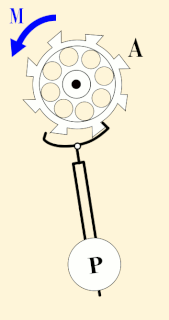
The second is the base unit of time in the International System of Units (SI), commonly understood and historically defined as 1⁄86400 of a day – this factor derived from the division of the day first into 24 hours, then to 60 minutes and finally to 60 seconds each. Analog clocks and watches often have sixty tick marks on their faces, representing seconds, and a "second hand" to mark the passage of time in seconds. Digital clocks and watches often have a two-digit seconds counter. The second is also part of several other units of measurement like meters per second for speed, meters per second per second for acceleration, and cycles per second for frequency.

A time zone is an area that observes a uniform standard time for legal, commercial and social purposes. Time zones tend to follow the boundaries between countries and their subdivisions instead of strictly following longitude, because it is convenient for areas in frequent communication to keep the same time.
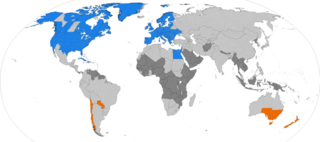
Daylight saving time (DST), also known as daylight savings time or daylight time, and summer time, is the practice of advancing clocks during warmer months so that darkness falls at a later clock time. The typical implementation of DST is to set clocks forward by one hour in the spring, and to set clocks back by one hour in autumn to return to standard time. As a result, there is one 23-hour day in late winter or early spring and one 25-hour day in autumn.

A circadian rhythm, or circadian cycle, is a natural, internal process that regulates the sleep–wake cycle and repeats roughly every 24 hours. It can refer to any process that originates within an organism and responds to the environment. These 24-hour rhythms are driven by a circadian clock, and they have been widely observed in animals, plants, fungi and cyanobacteria.

Noon is 12 o'clock in the daytime. It is written as 12 noon, 12:00 m., 12 p.m., 12 pm, or 12:00 or 1200 . Solar noon is the time when the Sun appears to contact the local celestial meridian. This is when the Sun reaches its apparent highest point in the sky, at 12 noon apparent solar time and can be observed using a sundial. The local or clock time of solar noon depends on the longitude and date.
The 12-hour clock is a time convention in which the 24 hours of the day are divided into two periods: a.m. and p.m.. Each period consists of 12 hours numbered: 12, 1, 2, 3, 4, 5, 6, 7, 8, 9, 10 and 11.
The 24-hour clock, popularly referred to in the United States and some other countries as militarytime, is the convention of timekeeping in which the day runs from midnight to midnight and is divided into 24 hours. This is indicated by the hours passed since midnight, from 0(:01) to 23(:59). This system, as opposed to the 12-hour clock, is the most commonly used time notation in the world today, and is used by the international standard ISO 8601.
Indian Standard Time (IST), sometimes also called India Standard Time, is the time zone observed throughout India, with a time offset of UTC+05:30. India does not observe daylight saving time or other seasonal adjustments. In military and aviation time IST is designated E* ("Echo-Star"). It is indicated as Asia/Kolkata in the IANA time zone database.

A clock face is the part of an analog clock that displays time through the use of a flat dial with reference marks, and revolving pointers turning on concentric shafts at the center, called hands. In its most basic, globally recognized form, the periphery of the dial is numbered 1 through 12 indicating the hours in a 12-hour cycle, and a short hour hand makes two revolutions in a day. A long minute hand makes one revolution every hour. The face may also include a second hand, which makes one revolution per minute. The term is less commonly used for the time display on digital clocks and watches.

A speaking clock or talking clock is a live or recorded human voice service, usually accessed by telephone, that gives the correct time. The first telephone speaking clock service was introduced in France, in association with the Paris Observatory, on 14 February 1933.

Summer time in Europe is the variation of standard clock time that is applied in most European countries in the period between spring and autumn, during which clocks are advanced by one hour from the time observed in the rest of the year, with a view to making the most efficient use of seasonal daylight. It corresponds to the notion and practice of daylight saving time (DST) to be found in many other parts of the world.
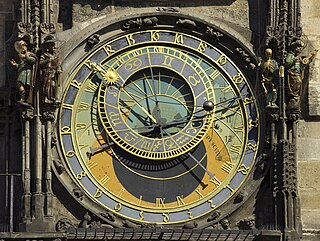
An astronomical clock, horologium, or orloj is a clock with special mechanisms and dials to display astronomical information, such as the relative positions of the Sun, Moon, zodiacal constellations, and sometimes major planets.

A striking clock is a clock that sounds the hours audibly on a bell or gong. In 12-hour striking, used most commonly in striking clocks today, the clock strikes once at 1:00 am, twice at 2:00 am, continuing in this way up to twelve times at 12:00 mid-day, then starts again, striking once at 1:00 pm, twice at 2:00 pm, up to twelve times at 12:00 midnight.

During British Summer Time (BST), civil time in the United Kingdom is advanced one hour forward of Greenwich Mean Time (GMT), in effect changing the time zone from UTC±00:00 to UTC+01:00, so that mornings have one hour less daylight, and evenings one hour more.
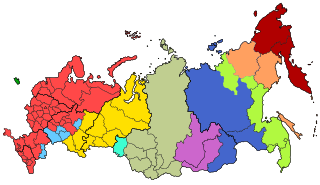
There are eleven time zones in Russia, which currently observe times ranging from UTC+02:00 to UTC+12:00. Daylight saving time (DST) has not been used in Russia since 26 October 2014. From 27 March 2011 to 26 October 2014, permanent DST was used.

Metronome is a large public art installation located along the south end of Union Square in New York City. The work was commissioned by the Related Companies, developers of One Union Square South, with the participation of the Public Art Fund and the Municipal Art Society. The $4.2 million provided by the developer makes it one of the largest private commissions of public art.
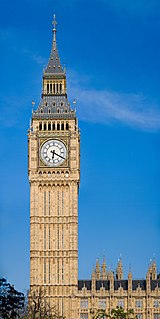
Big Ben is the nickname for the Great Bell of the striking clock at the north end of the Palace of Westminster in London, England, although the name is frequently extended to refer also to the clock and the clock tower. The official name of the tower in which Big Ben is located was originally the Clock Tower, but it was renamed Elizabeth Tower in 2012, to mark the Diamond Jubilee of Elizabeth II.

The six-hour clock, also called the Roman or the Italian system, was a system of date and time notation in Italy which preceded the modern 24-hour clock. In this system, the day starts at the evening Ave Maria at the end of twilight, approximately half an hour after sunset, and the following 24 hours are divided into four cycles of six hours each.
References
- ↑ "times". The Times Online Style Guide. 2011. Archived from the original on 4 August 2011. Retrieved 8 July 2017.